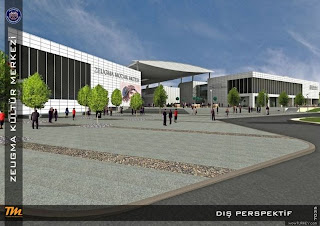Monday, November 15, 2010
Zeugma's Plundered Mosaics
Sunday, November 14, 2010
A Short Documentary on Zeugma
Ancient Soulmates?
Highlights from Zeugma Mosaic Museum's Collection
Poseidon, chief of the water deities and second in power only to Zeus, carried a trident, with which he could shake the earth, call forth or dissipate storms, and the like. To impress Demeter, who urged him to create the world's most beautiful animal, Poseidon invented the horse. Horses with brass hoofs and golden manes drew his chariot across the seas, which became calm before him.Homer claims Oceanus and Tethys, pictured in the lower half of this mosaic, were responsible for the birth of the gods, but Hesiod's version of the origins is generally accepted. Gods of the sea, Oceanus and his wife Tethys bore 3,000 daughters and 3,000 sons. Known as the Oceanids, these children were spirits of rivers, waters, and springs.





The Zeugma Mosaic Museum
Zeugma
Zeugma, which was founded in the 3rd-4th century B.C. by Seleucus Nicator I, one of Alexander the Great’s commanding generals, is situated at one of the easiest fording places on the Euphrates. Maybe therefore its name, ‘Zeugma’, means ‘bridgehead’ or ‘crossing place’. Thanks to its strategic situation on an east-west axis,the city quickly grew and developed, becoming one of the four major cities of the Commagene Kingdom founded in the 1st century B.C. in the post-Hellenistic period. When the region came under Roman hegemony, one of the empire’s thirty legions was stationed here, the 4th Scythian. Its presence fuelled trade, trade in turn brought wealth, and when that wealth attracted artists, Zeugma became a metropolis of 70 thousand people. On the banks of the Euphrates merchants built villas with a perfect view of the sunset. And in the courtyards of those villas they added refreshing, mosaic-paved pools. With their mosaics depicting Poseidon, Oceanus, Tethys and the river gods, these villas on the banks of the Euphrates transformed Zeugma into a virtual fine arts museum. Swelling shortly to twice the size of London and three times that of Pompeii, the city rivalled the Athens of its day. Though archaeological research in Zeugma goes back to the 1970s, most of what is known from the site was discovered during the extensive salvage excavations in 2000. Before large portions of it disappeared in 2000 beneath the rising waters of a several dam constructions on the Euphrates River, the ancient city of Zeugma yielded one of the richest troves of Roman mosaics ever uncovered. Now exhibited at Gaziantep Museum in downtown Gaziantep, the well-preserved mosaics depict a wide variety of mythological scenes and individuals. Those mosaics soon to be moved to a newly built Zeugma Mosaics Museum, constructed close to the ancient Zeugma and which will be the world's largest mosaic museum. This blog is dedicated to inform its readers on this new Zeugma Mosaic Museum and its rich collections.










